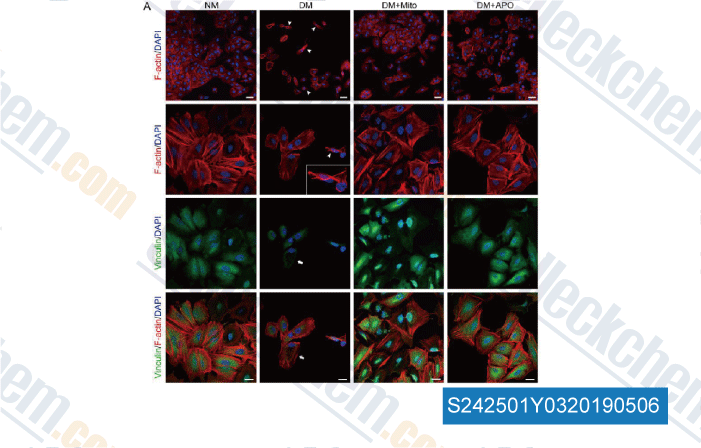|
Toll Free: (877) 796-6397 -- USA and Canada only -- |
Fax: +1-832-582-8590 Orders: +1-832-582-8158 |
Tech Support: +1-832-582-8158 Ext:3 Please provide your Order Number in the email. |
Technical Data
| Formula | C9H10O3 |
|||
| Molecular Weight | 166.17 | CAS No. | 498-02-2 | |
| Solubility (25°C)* | In vitro | DMSO | 33 mg/mL (198.59 mM) | |
| Ethanol | 33 mg/mL (198.59 mM) | |||
| Water | Insoluble | |||
|
* <1 mg/ml means slightly soluble or insoluble. * Please note that Selleck tests the solubility of all compounds in-house, and the actual solubility may differ slightly from published values. This is normal and is due to slight batch-to-batch variations. * Room temperature shipping (Stability testing shows this product can be shipped without any cooling measures.) |
||||
Preparing Stock Solutions
Biological Activity
| Description | Apocynin is a selective NADPH-oxidase inhibitor with IC50 of 10 μM. | ||
|---|---|---|---|
| Targets |
|
||
| In vitro | Apocynin is a naturally occurring methoxy-substituted catechol used as an inhibitor of NADPH-oxidase. Apocynin prevents serine phosphorylation of p47phox and blocks its association with gp91phox, thus blunting NADPH oxidase activation. [2] Apocynin can decrease the production of superoxide (O(2)(-)) from activated neutrophils and macrophages. Apocynin, after metabolic conversion, inhibits the assembly of NADPH-oxidase that is responsible for reactive oxygen species (ROS) production. [3] | ||
| In vivo | Apocynin has anti-inflammatory activity in a variety of cell and animal models of inflammation. Apocynin attenuates the TNF-α and IL-1β production and iNOS expression in the lung of carrageenan-treated mice. [4] Apocynin exerts beneficial effects in a mice model of spinal cord injury. Apocynin reduces (1) the degree of spinal cord damage, (2) neutrophils infiltration, (3) ICAM-1 and P-selectin expression, (4) PAR and nitrotyrosine formation, (5) IκB-α degradation, (6) NF-κB activation, (7) pro-inflammatory cytokines production (TNF-α and IL-1β), (8) apoptosis (TUNEL staining, FAS ligand expression, Bax and Bcl-2 expression) and (9) MAPK activation (P-38 and phospho-JNK). [5] LD50: Mice 9g/kg (i.g.). [3] |
Protocol (from reference)
References
Customer Product Validation

-
, , Int J Endocrinol, 2016, 2016:8354745.

-
Data from [Data independently produced by , , Acta Biomater, 2018, 73:470-487]

-
Data from [Data independently produced by , , Oxid Med Cell Longev, 2017, 2017:9738745]

-
Data from [Data independently produced by , , Mol Med Rep, 2016, 14(4):3525-34.]
Selleck's Apocynin has been cited by 34 publications
| NADPH Oxidase-Mediated Testicular Oxidative Imbalance Regulates the TXNIP/NLRP3 Inflammasome Axis Activation after Ischemia Reperfusion Injury [ Antioxidants (Basel), 2023, 12(1)145] | PubMed: 36671008 |
| Epicardial Adipose Tissue-Derived Leptin Promotes Myocardial Injury in Metabolic Syndrome Rats Through PKC/NADPH Oxidase/ROS Pathway [ J Am Heart Assoc, 2023, 12(15):e029415] | PubMed: 37489731 |
| Simulated microgravity reduces quality of ovarian follicles and oocytes by disrupting communications of follicle cells [ NPJ Microgravity, 2023, 9(1):7] | PubMed: 36690655 |
| Fisetin alleviates cellular senescence through PTEN mediated inhibition of PKCδ-NOX1 pathway in vascular smooth muscle cells [ Arch Gerontol Geriatr, 2023, 108:104927] | PubMed: 36645971 |
| Tryptophan-sorbitol based carbon quantum dots for theranostics against hepatocellular carcinoma [ J Nanobiotechnology, 2022, 20(1):78] | PubMed: 35164792 |
| Indoxyl sulfate reduces Ito,f by activating ROS/MAPK and NF-κB signaling pathways [ JCI Insight, 2022, 7(3)e145475] | PubMed: 35132967 |
| The pro-inflammatory effect of Staphylokinase contributes to community-associated Staphylococcus aureus pneumonia [ Commun Biol, 2022, 5(1):618] | PubMed: 35739262 |
| Porcine Enteric Coronavirus PEDV Induces the ROS-ATM and Caspase7-CAD-γH2AX Signaling Pathways to Foster Its Replication [ Viruses, 2022, 14(8)1782] | PubMed: 36016404 |
| Advanced oxidation protein products induce annulus fibrosus cell senescence through a NOX4-dependent, MAPK-mediated pathway and accelerate intervertebral disc degeneration [ PeerJ, 2022, 10:e13826] | PubMed: 35935259 |
| Xanthohumol-Induced Rat Glioma C6 Cells Death by Triggering Mitochondrial Stress [ Int J Mol Sci, 2021, 22(9)4506] | PubMed: 33925918 |
RETURN POLICY
Selleck Chemical’s Unconditional Return Policy ensures a smooth online shopping experience for our customers. If you are in any way unsatisfied with your purchase, you may return any item(s) within 7 days of receiving it. In the event of product quality issues, either protocol related or product related problems, you may return any item(s) within 365 days from the original purchase date. Please follow the instructions below when returning products.
SHIPPING AND STORAGE
Selleck products are transported at room temperature. If you receive the product at room temperature, please rest assured, the Selleck Quality Inspection Department has conducted experiments to verify that the normal temperature placement of one month will not affect the biological activity of powder products. After collecting, please store the product according to the requirements described in the datasheet. Most Selleck products are stable under the recommended conditions.
NOT FOR HUMAN, VETERINARY DIAGNOSTIC OR THERAPEUTIC USE.
